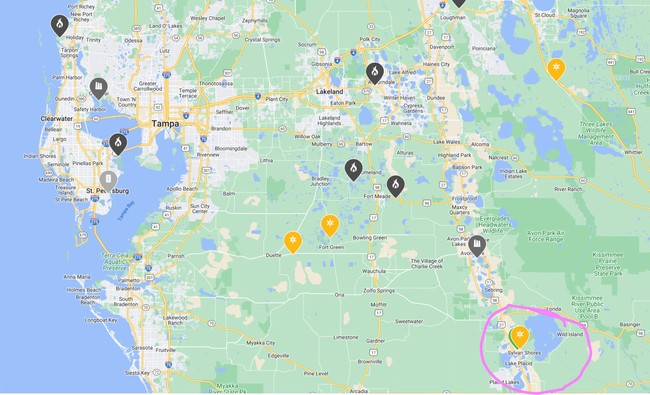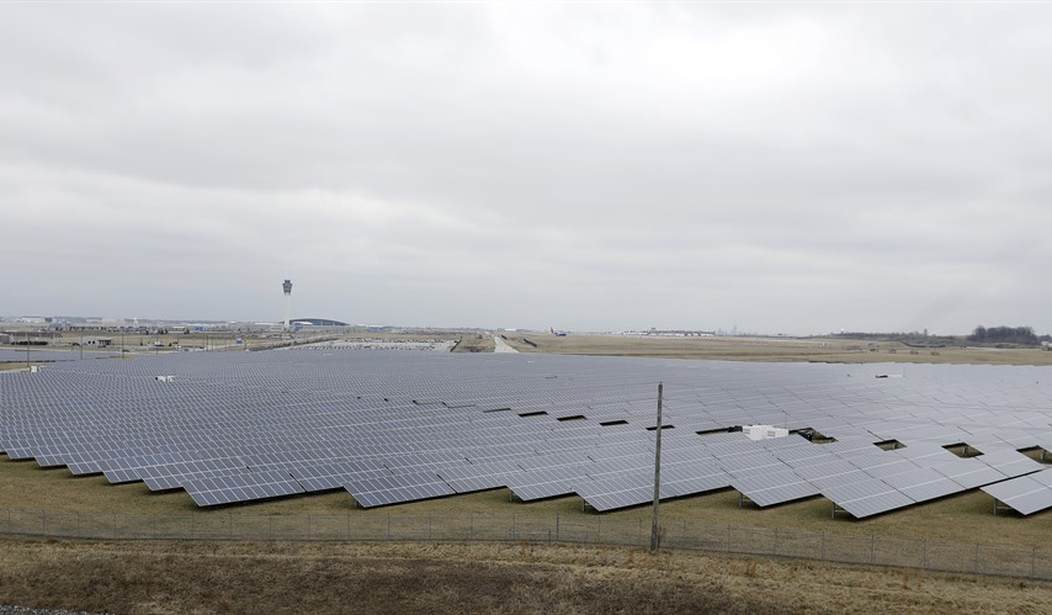You know, I'm glad you asked. Lemme show you.
What Hurricane Milton did to a Duke Energy solar farm in Florida. https://t.co/3JJuQPHo2d pic.twitter.com/w2QV5WA9l7
— Steve Milloy (@JunkScience) October 13, 2024
Beats those piddly hailstorm dinks all to pieces, doesn't it?
What this big frickin' mess, with the tornado tire tracks running right through the middle like someone used a shovel in snow, is called is the 'Lake Placid Solar Plant'. It's part of Duke Energy's Florida operations and is located out in the Central FL swamps, which is also, coincidentally, where Hurricane Milton blew through, accompanied by a mind-blowing number of tornadoes in those outer bands.
The circled yellow tag is the facility and the green tag peeking out from behind it is the battery storage for it.
 The 180,000 panels, 45MW Lake Placid solar farm was apparently groundbreaking for its day, as the battery storage addition in 2019 was a 'first of its kind' for Duke in FL. According to the company's cheat sheet on the site, when it's humming at full operation, it can power some 23,000 homes.
The 180,000 panels, 45MW Lake Placid solar farm was apparently groundbreaking for its day, as the battery storage addition in 2019 was a 'first of its kind' for Duke in FL. According to the company's cheat sheet on the site, when it's humming at full operation, it can power some 23,000 homes.
Or it did.
Clean-up will be a bear, and I'm curious what they're going to do with all the toxic panels. I knew what hurricane debris piles look like just from neighborhood clean-ups, and this is a horse of a different color. I am very curious if they waive the environmental disposal regs for it because "disaster" or if they'll actually have to follow them.
Now, they're lucky, as with all of these renewable fantasy sites, that they have to have fossil fuel back-up even to maintain the fiction that they work. Duke has several natural gas-fired plants within striking distance of the destroyed solar farm - three you can see on the slice I took of their FL map. They're the black icons with the wee flame on them.
The 43,000 customers out of 60,000 in their base who were still without power as of Friday morning are getting a little fractious about when the lights are coming back on. If they had to depend solely on the solar farm, well...they'd be Schlitz out of luck.
The company is aware of the problem with the news and has made sure to get the word passed that the shattered panels have nothing to do with whether your power comes on or not.
Feeling powerless? You’re in good company.
Hurricane Milton made landfall Wednesday night in Siesta Key. As he traveled across the state wreaking havoc, power lines and poles were knocked out leaving most of Highlands County in the dark. Duke Energy was slated to give estimated times of restoration (ETR) Friday afternoon.
As of 10:30 a.m. Friday, Duke spokesperson Audrey Stasko said there were some 43,000 customers without power out of more than 60,000 customers. About 12,000 customers were restored Friday morning. County officials said 97% of the county was without power immediately after the storm.
...Duke Energy suffered damage to its solar power plant in Lake Placid. Stasko confirmed a tornado was responsible. From a bird’s eye view, a large swath of damaged solar panels is evident.
“We are still assessing the extent of the damage,” Stasko said. “It has no effect on customer demand.”
IT HAS NO EFFECT ON CUSTOMER DEMAND
And why?
You can thank a natural gas-fired power plant for lights today when there are no solar panels tomorrow.
That's why.
The people whose homes were 'powered' by that field will never even know it was gone.
Until they get the tab to replace it.
What a waste.
Speaking of waste, what about the toxins and heavy metals strewn across the landscape when the better part of 180,000 solar panels get blasted into smithereens? This isn't the hail storms in TX and elsewhere, with pockmarks and divots.
These suckers are tiny pieces, most of which got blown God knows where.
There were already serious concerns about recycling the unrecyclable - what about these cases? They've reduced the amount of cadmium and lead supposedly - I don't know what other chemicals are contained inside. But then there's the question of how they've made them more durable.
...The vast majority of solar panels currently use toxic and highly persistent PFAS chemicals in the outer layer to ensure durability. In 2022, the market share for PFAS materials in these outer layers was close to 80%, while PFAS-free alternatives accounted for only one-fifth.
But the real problem of PFAS in solar panels is yet to be seen.
“Most of these products have no characteristic for recycling or other circular use of the materials”, says Huib van den Heuvel, Chief Commercial Officer at Solarge, a Dutch solar energy company.
Duke sure could have spent that money on better things. Maybe ratepayers ought to insist on it going forward.
Duke Energy Florida has invested over $2.3B of FL ratepayer $$ on 13,400 acres of solar in past 4 years…if on transformers & other grid hardening, and far higher density generation instead, we’d be far better off.
— Dr. Thomas Hoke (@hoke_thomas) October 13, 2024
It's not as if hurricanes and tornadoes are an unusual occurrence in this neck of the woods.
But that would take common sense and not climate cult obeisance.
That and a healthy appetite for government hand-outs.
Duke Energy Florida Solar Farm Destroyed by Hurricane Milton |
— Andrea Shaffer, Employment/Labor Law (@Andreafreedom76) October 13, 2024
Florida is ranked third in the nation for total solar power generation capacity and accounts for about 5% of total electricity output. Florida offers plenty of sunshine to help generate electricity from solar panels… pic.twitter.com/nDb5frTdZS
...Florida offers plenty of sunshine to help generate electricity from solar panels but if they are destroyed on a frequent basis by hurricanes and storms, are they really the most cost effective energy source for power generation?
Commercial solar panels typically cost about $325,000, with average costs in the US ranging between $50,000 and $600,000.
Duke Energy’s solar generation portfolio represents more than $2 billion of investment, about 1,500-MW of emission-free generation and approximately five million solar panels in the ground by 2024.
Duke Energy is executing an aggressive clean energy strategy to create a smarter energy future for its customers and communities – with goals of at least a 50 percent carbon reduction by 2030 and net-zero carbon emissions by 2050.
As of 2024, natural gas is the market n source of energy fueling our power companies.
So...if Duke ever achieved their NetZero goals for FL, how do they turn the lights back on when they shut the last natgas plant down and this happens?
True believers need to think about that, no?
When folks get their power back on, and, God willing, Trump wins the election? I'll be really curious to see how fast Duke builds themselves another solar glass disaster.
Because it's probably gonna be on their dime this time, and if there's one thing these companies aren't fond of doing, it's burning their own money.







Join the conversation as a VIP Member